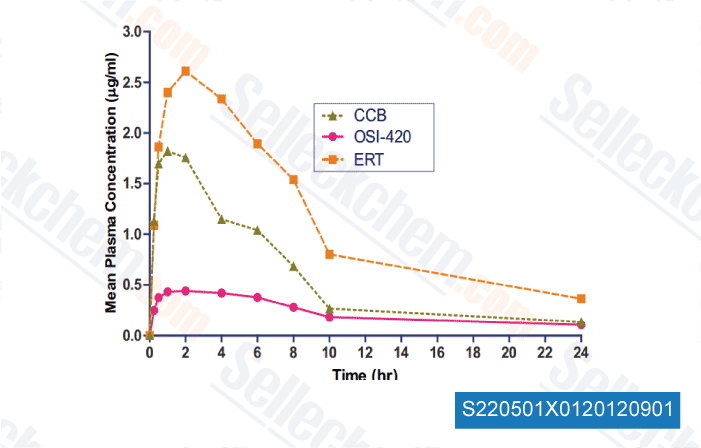|
Toll Free: (877) 796-6397 -- USA and Canada only -- |
Fax: +1-832-582-8590 Orders: +1-832-582-8158 |
Tech Support: +1-832-582-8158 Ext:3 Please provide your Order Number in the email. |
Technical Data
| Formula | C21H21N3O4.HCl |
|||
| Molecular Weight | 415.87 | CAS No. | 183320-51-6 | |
| Solubility (25°C)* | In vitro | DMSO | 83 mg/mL (199.58 mM) | |
| Water | Insoluble | |||
| Ethanol | Insoluble | |||
|
* <1 mg/ml means slightly soluble or insoluble. * Please note that Selleck tests the solubility of all compounds in-house, and the actual solubility may differ slightly from published values. This is normal and is due to slight batch-to-batch variations. * Room temperature shipping (Stability testing shows this product can be shipped without any cooling measures.) |
||||
Preparing Stock Solutions
Biological Activity
| Description | DesMethyl Erlotinib (OSI-420) HCl is the active metabolite of Erlotinib (EGFR inhibitor with IC50 of 2 nM). | ||
|---|---|---|---|
| Targets |
|
||
| In vitro | OSI-420 is the major metabolite of Erlotinib in human plasma. Erlotinib disappearance from plasma after a short IV infusion is biexponential with a mean terminal half-life of 5.2 h and a mean clearance of 128 ml/min per m(2). OSI-420 exposure (AUC) in plasma is 30% (range 12-59%) of erlotinib, and OSI-420 clearance is more than 5-fold higher than erlotinib. Erlotinib and OSI-420 are equipotent, and the combined concentrations of erlotinib + OSI-420 achieved in the CSF exceeded the IC50 (7.9 ng/ml or 20 nM) for the EGFR tyrosine kinase inhibition in intact tumor cells. [1] Erlotinib potently inhibits EGFR activation in intact cells including HNS human head and neck tumor cells (IC50 20nM), DiFi human colon cancer cells andMDA MB-468 human breast cancer cells. Erlotinib (1 μM) induces apoptosis in DiFi human colon cancer cells. [2] Erlotinib inhibits growth of a panel of NSCLC cell lines including A549, H322, H3255, H358 H661, H1650, H1975, H1299, H596 with IC50 ranging from 29 nM to >20 μM. [3] Erlotinib(2 μM) significantly inhibits growth of AsPC-1 and BxPC-3 pancreatic cells. [4] The effects of Erlotinib HCl in combination with gemcitabine are considered additive in KRAS-mutated pancreatic cancer cells. Ten micromolar of Erlotinib inhibits EGFR phospho-rylation at the Y845 (Src-dependent phosphorylation) and Y1068 (auto-phosphorylation) sites. [5] Combination with Erlotinib could down-modulate rapamycin-stimulated Akt activity and produces a synergistic effect on cell growth inhibition. [6] | ||
| In vivo | At doses of 100 mg/kg, Erlotinib completely prevents EGF-induced autophosphorylation of EGFR in human HN5 tumors growing as xenografts in athymic mice and of the hepatic EGFR of the treated mice. [1] Erlotinib reduces the growth of xenografted human AML cells. [4] | ||
| Features | OSI 420 is a major active metabolite of Erlotinib. |
Protocol (from reference)
| Kinase Assay: |
|
|---|---|
| Cell Assay: |
|
| Animal Study: |
|
References
Customer Product Validation

-
Data from [Sci Pharm, 2012, 80, 633-646 ]
Selleck's DesMethyl Erlotinib (OSI-420) HCl has been cited by 24 publications
| Simultaneous quantification of atorvastatin, erlotinib and OSI-420 in rat serum and liver microsomes using a novel liquid chromatography-mass spectrometry method [ J Pharm Biomed Anal, 2023, 236:115716] | PubMed: 37722165 |
| Early [18]FDG PET/CT scan predicts tumor response in head and neck squamous cell cancer patients treated with erlotinib adjusted per smoking status [ Front Oncol, 2022, 12:939118] | PubMed: 36110959 |
| Establishment and Characterization of NCC-PMP1-C1: A Novel Patient-Derived Cell Line of Metastatic Pseudomyxoma Peritonei [ J Pers Med, 2022, 12(2)258] | PubMed: 35207746 |
| Major histocompatibility complex class I molecule expression by pancreatic cancer cells is regulated by activation and inhibition of the epidermal growth factor receptor [ Immunol Res, 2022, 10.1007/s12026-022-09262-3] | PubMed: 35303241 |
| Establishment and characterization of NCC-UPS4-C1: a novel cell line of undifferentiated pleomorphic sarcoma from a patient with Li-Fraumeni syndrome [ Hum Cell, 2022, 10.1007/s13577-022-00671-y] | PubMed: 35118583 |
| Establishment and characterization of NCC-MFS4-C1: a novel patient-derived cell line of myxofibrosarcoma [ Hum Cell, 2021, 34(6):1911-1918] | PubMed: 34383271 |
| Establishment and characterization of the NCC-GCTB4-C1 cell line: a novel patient-derived cell line from giant cell tumor of bone [ Hum Cell, 2021, 10.1007/s13577-021-00639-4] | PubMed: 34731453 |
| Establishment and characterization of novel patient-derived cell lines from giant cell tumor of bone [ Hum Cell, 2021, 10.1007/s13577-021-00579-z] | PubMed: 34304386 |
| Bioanalysis of erlotinib, its O-demethylated metabolites OSI-413 and OSI-420, and other metabolites by liquid chromatography-tandem mass spectrometry with additional ion mobility identification [ J Chromatogr B Analyt Technol Biomed Life Sci, 2021, 1166:122554] | PubMed: 33540147 |
| Establishment and characterization of patient-derived cancer models of malignant peripheral nerve sheath tumors. [ Cancer Cell Int, 2020, 19;20:58] | PubMed: 32099531 |
RETURN POLICY
Selleck Chemical’s Unconditional Return Policy ensures a smooth online shopping experience for our customers. If you are in any way unsatisfied with your purchase, you may return any item(s) within 7 days of receiving it. In the event of product quality issues, either protocol related or product related problems, you may return any item(s) within 365 days from the original purchase date. Please follow the instructions below when returning products.
SHIPPING AND STORAGE
Selleck products are transported at room temperature. If you receive the product at room temperature, please rest assured, the Selleck Quality Inspection Department has conducted experiments to verify that the normal temperature placement of one month will not affect the biological activity of powder products. After collecting, please store the product according to the requirements described in the datasheet. Most Selleck products are stable under the recommended conditions.
NOT FOR HUMAN, VETERINARY DIAGNOSTIC OR THERAPEUTIC USE.
